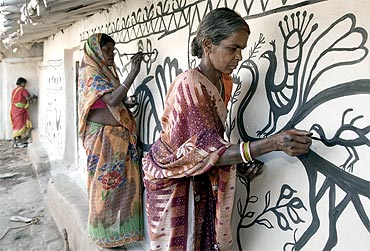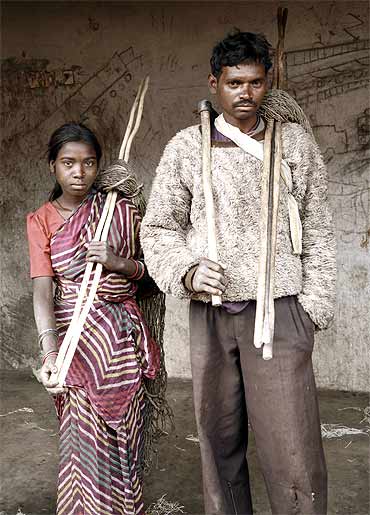 | « Back to article | Print this article |
Living on the edge of a disappearing world
An American photojournalist, who ventured into strife-torn tribal areas of Jharkhand while the Maoist insurgency was in full swing, has documented how irresponsible mining is usurping the lives of tribal people.
Freelance photographer Robert Wallis' photographs are currently on display at the Brunei Gallery in London, in an exhibition titled A Disappearing World: Ancient Traditions Under Threat in Tribal India.
Wallis, who travelled to Jharkhand in 2006 and 2010, tried to portray how the tribal people were losing their livelihood gradually to large corporations and state mining companies who were taking over their land.
The 58-year-old told rediff.com, "I was at an environmental conference in London when I met some Indian activists who told me about the environmental disaster happening with open pit coal and uranium mining. They said they would show me these things if I came to Jharkhand."
Wallis, who has worked for Time and Newsweek, had visited India in 1997 to cover the 50th anniversary of Independence.
"That was all about the IT sector, the new boom and the Indian tiger economy," he recalled.
Also See: Robert Wallis's Jharkhand multimedia (External link)
Reportage: Naomi Canton
'Tribals want their forests and way of life protected'
Helped by the activists he had met in London, Wallis travelled around Jharkhand in 2006 in a jeep, with just a translator and a 'fixer', visiting tribal villages and concrete camps that Adivasis had been forcibly resettled to after the government had leased their land to companies for open-pit mines, large dams and steel mills.
In spite of travelling through the heartland of Maoist insurrection, Wallis, who stayed in Ranchi and Hazaribag, said he did not personally witness any violence, although 12 adivasi protesting against ground-breaking for a new Tata steel mill at Kalinga Nagar in the neighbouring state of Orissa were gunned down by police while he was in Jharkhand and Maoists were launching attacks on police in other areas.
"I'm sure the Maoists knew we were there. Travelling at night we saw people in the forest with walkie talkies, but they didn't contact us. Whenever we drove through forests after dark we honked our horns and flashed our headlights, so as not to be mistaken as the police who would go in quietly," he said.
"But, as far as I was aware, the adivasis I met in the villages had no connection with the Maoists," he said.
"They were trying to use art as a means of resistance and to preserve their traditional culture against the onslaught of mining. A lot of them would simply like to be left alone to live their own lives based on agrarian farming, hunting and gathering in the forests," he said.
And, as both the forests and their ancestral graves are sacred to adivasi, when they are forced off their land and into resettlement camps, they lose all connections to who they are as a people.
But, he explained, the mining companies wanted their land because of the rich minerals that lay underneath, to feed India's economic boom and reap huge profits.
"This is forcing tribal people who were not political at all, who want to be farmers, to turn to Maoists for protection and stop their villages from being burnt down. Maoism isn't an ideology tribals normally think about in the sense that Maoists want to overthrow the Indian government. They just want their forests and way of life protected and some have turned to the Maoists (for that)," he said.
Image: A courtyard in the village of Jorakath is being decked up for a wedding ceremony. The painting traditions of Khovar (for weddings) and Sohrai (for harvest festivals) has been handed down from mothers to daughters for generations but is becoming rarer as traditional mud buildings are replaced with brick construction and pressure from mining impacts traditional village life.
'These projects don't benefit tribal people'
But according to Wallis, 90 per cent of Maoists comprise tribal people.
"The result of these industrial projects is of no benefit to the tribal people as the electricity (generated here) is going to places like Delhi and the iron ore is going to China. The tribal people don't even have electricity in their villages, even though they are being displaced to make way for coal-fired power stations," he explained.
There was no work for the Adivasis once their land had been snatched away, he said. They could not find employment on the mines, which required men who can operate mechanised digger drivers.
"Even if they are paid a compensation when their land is taken away, it's way below the value of the land and a lot of it gets lost in corruption. It's not enough to buy any new land so their way of life is lost. I saw some Adivasis scavenging for coal on the edge of the mines, others were migrating to cities and becoming day labourers on construction sites and losing contact with their old way of life," he said.
"The whole landscape is changing," he said, explaining how one minute he had photographed traditional tribal villages as of yet untouched by mining, the next he shot the remains of whole villages that had been wiped out and left crumbling on the edge of open-pit mines. He also saw roads dug through remnants of huge swathes of forest that had now vanished.
He said he met some tribes who traditionally hunted game such as deer, but with the receding forest, animals too were disappearing.
He described the people he met in concrete camps as "listless". They had "no connection with their environment anymore" and they could not continue ancient traditions such as painting their mud homes or worshipping nature.
Image: Men loading coal into rail cars at Sauanda railway yard. As agricultural land is dug up for mining, work in mines or in mine related activities is often the only option for survival for displaced farming communities.
'India has to protect its traditional way of life'
He returned to Jharkhand in January 2010 to see how the situation had changed and he found that not only had mines become more prevalent, but fires caused by simmering old mines were spreading uncontrollably underground, wiping out villages
He said owing to his connections, he had no problems taking pictures of the tribals but when he took photographs of the mines, he had to be fast as the guards usually called security.
But it was seeing children aged eight carrying chunks of coal weighing 20 kilos in their hands across coalfields barefoot that shocked him the most.
"They are scavenging because they have no chance to go to school and their agricultural life has been lost forever," he said.
Wallis hopes his exhibition will raise awareness of "an underreported story."
"My belief is that the only way India will really prosper if it protects its traditional way of life -- some people may call Adivasi life primitive, but it's sustainable," he added.
The exhibition, 'A Disappearing World: Ancient Traditions Under Threat in Tribal India', is on at the Brunei Gallery, SOAS, London until June 25, 2011. Go to http://www.soas.ac.uk/gallery/disappearingworld for more information.
Image: The Birhor Adivasi are the last remaining tribal group in Jharkhand who still attempt to live a hunting/ trapping/gathering life as they have for thousands of years. But due to the pressures of mining and logging, the habitat for wild animals is rapidly disappearing along with the Birhor's way of life which depended on plants and animals. Most have given up their formerly nomadic life to live in concrete government resettlement camps. Here, a Birhor couple have returned to their resettlement camp from an unsuccessful hunt with their traditional nets. On the wall behind them can be seen graffitied images of coal trucks, the new reality they are facing.



